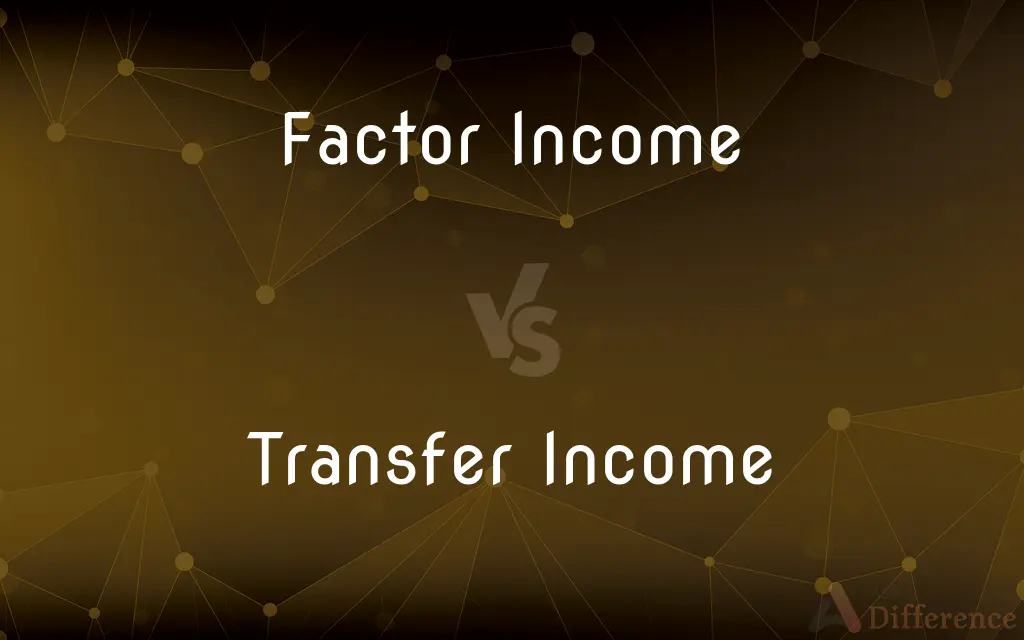Factor Income vs. Transfer Income — What's the Difference?
By Tayyaba Rehman — Published on October 28, 2023
s derived from factors of production (like labor or capital); Transfer Income involves payments without a return service or good, e.g., welfare. Difference lies in earnings vs. received without providing services.

Difference Between Factor Income and Transfer Income
Table of Contents
ADVERTISEMENT
Key Differences
Factor Income primarily emanates from utilizing factors of production such as labor, capital, and entrepreneurship in the production process. Transfer Income, however, doesn’t correlate with production but is still a financial inflow, mostly in the form of governmental or institutional assistance without a direct exchange of goods or services.
Factor Income and Transfer Income impact the economy differently. The former, indicative of economic activity and productivity, injects value, originating from productive use. Contrastingly, Transfer Income indicates redistribution of resources, circulating wealth without linking to productivity or employment.
Factor Income constitutes the primary resource for calculating Gross Domestic Product (GDP) since it is directly linked to production. Transfer Income does not contribute to GDP since it’s not derived from production or services and, therefore, does not reflect economic productivity.
Regularity and expectations of income differ between Factor Income and Transfer Income. The former tends to be regular and is expected based on employment or ownership of productive assets. Transfer Income, however, can be irregular and is often subject to specific eligibility criteria.
From a policy perspective, Factor Income and Transfer Income are crucial for different reasons. While Factor Income highlights productive capacities and economic vitality, Transfer Income signifies societal welfare measures, reflecting on social stability and wealth redistribution mechanisms.
ADVERTISEMENT
Comparison Chart
Source
Comes from factors of production (labor, capital, etc.)
Sourced from governmental or institutional aid.
Relation to Production
Directly related to production.
Not related to production or services rendered.
Contribution to GDP
Directly contributes to GDP.
Does not contribute to GDP.
Regularity
Typically regular and expected.
Can be irregular and often subject to criteria.
Economic Indication
Indicates economic activity and productivity.
Indicates wealth redistribution and social support.
Compare with Definitions
Factor Income
Factor Income contributes to Gross Domestic Product calculations.
The national GDP includes Factor Income from various economic sectors.
Transfer Income
Transfer Income is crucial for societal welfare and support.
Social security payments are a Transfer Income form aiding retirees.
Factor Income
Factor Income is subject to taxation and forms a government revenue source.
The government uses Factor Income taxes to fund public services.
Transfer Income
Transfer Income does not contribute to GDP calculations.
Welfare payments, as Transfer Income, aren’t part of GDP computations.
Factor Income
Factor Income is financial inflow derived from utilizing productive factors.
Salaries from employment constitute a common form of Factor Income.
Transfer Income
Transfer Income can be subject to eligibility criteria and restrictions.
Access to certain Transfer Income types might require specific qualification.
Factor Income
Factor Income correlates with economic productivity and value creation.
The factory's production directly creates Factor Income for its workers.
Transfer Income
Transfer Income represents governmental or institutional financial support.
The pension she receives monthly is classified as Transfer Income.
Factor Income
Factor Income includes wages, interest, rent, and profit.
His Factor Income includes wages from work and interest from investments.
Transfer Income
Transfer Income involves receiving money without providing services or goods.
Unemployment benefits are a type of Transfer Income.
Common Curiosities
Is rent considered Factor Income?
Yes, it’s income from providing a factor of production.
Does Transfer Income always come from public funds?
Often, but it can also come from private institutions.
Do businesses receive Factor Income?
Yes, through profits from production.
Can Factor Income fluctuate?
Yes, based on economic conditions and productivity.
Is Transfer Income essential for economic stability?
Yes, it provides financial stability for recipients.
What is a common form of Factor Income?
Wages or salaries from employment.
Can Transfer Income be provided by non-government entities?
Yes, such as charitable organizations.
Does Factor Income play a role in economic development?
Yes, indicating and contributing to economic activity.
Are dividends a form of Factor Income?
Yes, they're profits distributed to shareholders.
Does Transfer Income play a role in poverty alleviation?
Absolutely, by providing financial support to those in need.
Are scholarships considered Transfer Income?
Generally, yes, as they're not exchanged for goods/services.
Can Transfer Income assist in addressing economic inequality?
Yes, by redistributing wealth and providing financial support.
How does Transfer Income support low-income individuals?
By providing financial aid without requiring service in return.
Can Factor Income impact governmental fiscal policy?
Indeed, it influences and is influenced by taxation and spending policies.
Is interest earned on savings a type of Factor Income?
Yes, it’s income derived from providing capital.
Share Your Discovery

Previous Comparison
President vs. Prime Minister
Next Comparison
Home Country vs. Host CountryAuthor Spotlight
Written by
Tayyaba RehmanTayyaba Rehman is a distinguished writer, currently serving as a primary contributor to askdifference.com. As a researcher in semantics and etymology, Tayyaba's passion for the complexity of languages and their distinctions has found a perfect home on the platform. Tayyaba delves into the intricacies of language, distinguishing between commonly confused words and phrases, thereby providing clarity for readers worldwide.
















































